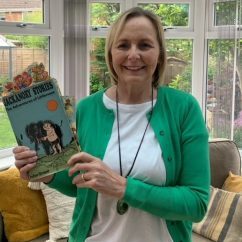“Objects & Their Stories” is a new course developed by Coram-i and CoramBAAF designed for foster carers and social workers to help support their personal and professional development. In this blog, Morven Nelson reflects on her experience of attending the sessions.

About me
I’m a Life Story Co-ordinator and Therapeutic Life Story Worker for my local authority. There is a statutory obligation for children who are adopted to receive a life story book as part of the adoption process. At our local authority we would like every child in care to receive life story work, and a life story book. My role is to implement life story work into Children Services and to support the foster carers in the creation of a life story book depicting the childs stay with them as fully as possible. On occasion, when time allows, I will undertake a referral for therapeutic life story work. It’s so important for children to know and understand their own stories. What I do is very much child lead, moving at their pace and following their agenda. I’ve been working with children for 16 years now but I’m very aware that my life wouldn’t have taken this turn if we hadn’t adopted our son and begun to understand the importance of a childs formative early years. When I heard about the Objects and Their Stories course, I knew instantly that this was something that I wanted to do. I’ve always been curious about objects and was aware that there were objects in my life that have meaning for me. I could also see that there would be really helpful applications in both aspects of my work.
Objects in my own story
As part of the course, we were invited to choose an object that had significant history for us and share it with the group. I picked a book associated with a television programme that will be familiar to people who grew up in the seventies and eighties: a “Jackanory“ storybook. I was given the book when I was nine years old by a friend of the family, a producer at the BBC, who arranged for me to visit the studios. I have very fond memories of that day which was a really special time. I remember he took me to the make-up room, and I had a pretend scar put onto my face – it eventually rubbed off when I fell asleep on the bus on the way home!
The book itself is a story called “The Adventures of Little Nose” and it was really important to me. It’s still full of clippings and scraps that I exchanged with my school friends. But reflecting on how this object came into my life, I wonder whether it may have even greater significance that I realised at the time. My father actually died when I was young and looking at the date in the book, this trip was just before his death. I’m not sure whether my parents were trying to cheer me up by arranging such a treat for me. In any event, one of the things I took away from the course was the fact that objects can be multi-faceted. They can have different associations and meanings that reveal themselves over time. That’s something l will carry through with my work with children. I want to be sure to recognise and honour the objects that they bring with them.
Objects as tools for communication
Reading up on the course I felt this was an area that I was already touching on in my work, but not consciously. For example, when I first began working with a child we’ll sometimes talk about objects that have special meaning to them. This approach was a key part of the “Objects and Their Stories” course and although our group only met over six weekly sessions, it felt like we all got to know each other really well. There was no pressure, but people did share and open up. I think we found out more about each other through the objects than we would during normal conversation. I was struck by how helpful this approach could be in a professional environment and my plan is to introduce some of the things I’ve learned to the social workers and families that I work with. I’ll definitely talk about it in the presentations that I’m giving across the teams in Children Services.
Everyone will benefit from doing this course
Initially I’d thought it would be hard to find objects with meaning. But once you start thinking about it, objects all around us seem to have new significance and memories attached to them. The most unlikely thing – an old ornament or maybe a broken toy – can have real importance. Once you start thinking about objects and their stories, you can’t see things around you in the same way again. So many people will get so much benefit from this work. I’d urge anyone thinking about taking the course to do it. You will not look back.
The next “Objects & Their Stories” course will take place in September. For more information visit the CoramBAAF website here.
